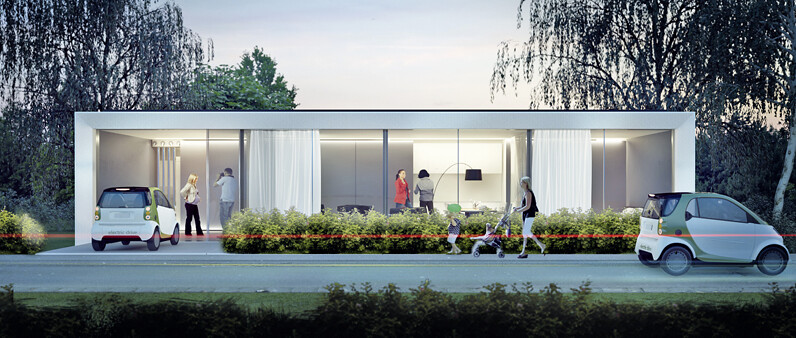A House That Generates Twice as Much Energy as It Actually Requires
Imagine a house, controlled entirely from your smartphone, that generates enough of its own electricity to not only power itself, but also its neighbours.
This house is currently in a stage somewhere between dream and reality.
The B10 Haus is an intelligent design project being tested in Germany, where I spent a week checking out how the country’s technological efforts stack up against innovation in Canada. The idea behind B10 is this: a modular home, which can be assembled in as little as one day, generates a surplus of energy, while its functions, such as turning on lights and opening blinds, can be activated remotely via a mobile app that learns behaviours to operate the most efficient house possible.
Thanks to a sophisticated energy concept and a self-learning building control system the house generates twice as much energy as it actually requires itself. The excess energy can provide power for two electric cars. The building will be fully deconstructed at the end of the project and rebuilt elsewhere or 100% recycled.
It’s a futuristic notion, yes—indeed, it hasn’t quite been proven possible. But the designers of B10 believe it is well within their grasp. The house exists, first of all. Second, it’s generating a surplus of energy—not their goal of 100% extra, but a surplus nonetheless (excess energy would be stored in batteries or used to power nearby, traditional homes). Third, the app, while partial to glitches, also exists. A press of the thumb on a smartphone or tablet can activate all sorts of functions within the home.
There a full range of appliances, all electric of course, and no furnace. Power hails from a slate of solar panels off the roof, and that power is optimized in a couple of ways—the windows, strategically placed, are glazed, and the insulation is thick. An attention to detail is evidence; almost the entire house is recyclable, for example, and customization opportunities are everywhere. Lights can be moved along tracks, while the ceiling panels can be done up in virtually any colour.

Currently the house is being used as an office, but later will become a real house for live-in testers.
In a first phase interested visitors to B10 will be able to learn about the energy concept and the building technology put to use. During the second phase, two students will be allowed to live in the building free of charge. Throughout the entire life of the project the energy generated and consumed as well as a large spectrum of data highly relevant to building research will be measured continuously and scientifically evaluated at the University of Stuttgart.
This test house is small, but don’t let that deter you. It’s only small because of physical site restrictions. The house’s modular design means it could very easily be bigger, and a second floor could be stacked on top, according to Thorsten Klaus, a Canadian-born engineer working at alphaEOS, one of the companies involved in the project, who told Techvibes that, while these test models often look and feel sterile and generic, that’s merely for the sake of simplicity. He notes that these houses, if they actually became mainstream, could have any number of colour and texture combinations, as well as specific floorplans. Plus, furniture isn’t yet a part of the internet of things, so your antique, character-rich armoire is welcome in even the most futuristic of properties.
The house, which is comprised almost entirely of recyclable materials, is setting a standard for efficient living in Germany. And while smart homes carry their own array of concerns, it sure would be amazing to survive cold Canadian winters with just self-generated electricity.




